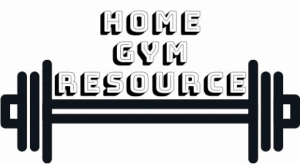Treadmills are the most popular cardio machine for getting and staying in shape and burning calories. Every gym in the world has them but is 30 minutes a day on a treadmill enough to see the results you want? That’s what we’ll dive into in this article.
Using a treadmill for 30 minutes at moderate intensity burns an average of 288 calories (weight and speed-dependent). After 3-4 weeks of using a treadmill for 30 minutes a day, you should begin to see results. Others will be able to notice these results after 6-8 weeks.
How many calories you burn every 30 minutes on a treadmill and how long it takes to see results depends on a lot of different factors. We’ll go into those factors a bit more below.
Contents
How Many Calories Does 30 Minutes on a Treadmill Burn?
Wondering how many calories you can burn in just 30 minutes on a treadmill? Well, it depends on how you use it. Let’s break it down into different types of workouts.
Remember that these calorie estimates are rough averages and individual results may differ. Even though speed is a very important factor in how many calories you burn, there are some other’s that have a large impact which is why you can find such a wide range of calories burnt.
Here are factors that impact how many calories you burn on the treadmill:
Time and speed are covered in the parts below. However, age, weight, and incline can still differ which is why there is a wide range of calories burnt.
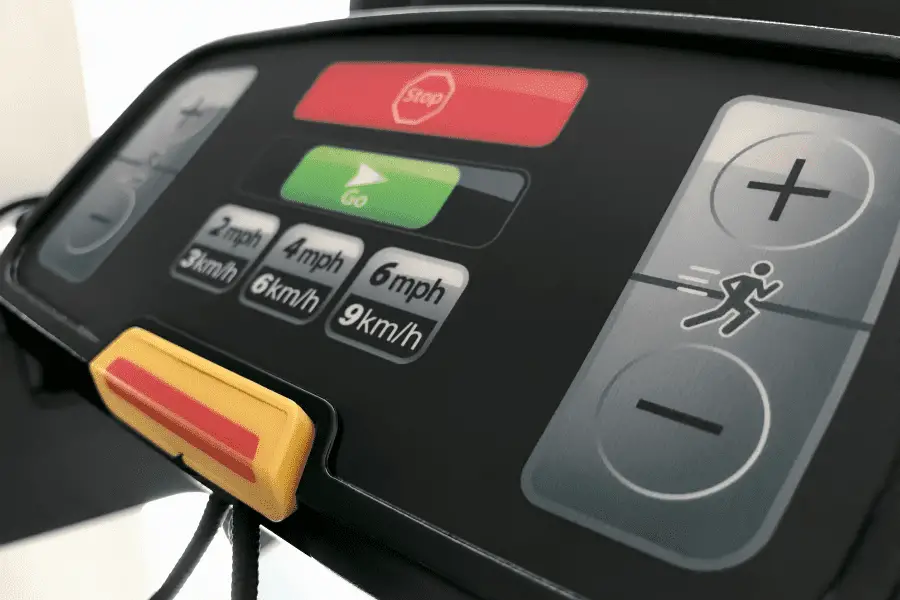
How Many Calories Does 30 Minutes Of Walking On A Treadmill Burn?
Walking on a treadmill at a moderate pace for 30 minutes can help you burn approximately 120 to 200 calories, depending on factors like your weight and walking speed. It’s a great low-impact exercise option for beginners.
The average person walks around 3-4 MPH so the estimate is for 3.5 miles per hour.
How Many Calories Does 30 Minutes Of Jogging On A Treadmill Burn?
If you prefer jogging on the treadmill, you can burn more calories in the same amount of time. Jogging for 30 minutes at about 5 MPH helps you torch around 240 to 400 calories. This is a bit more intense than walking but still achievable for many fitness levels.
How Many Calories Does 30 Minutes Of Running On A Treadmill Burn?
For those who enjoy a faster pace, running on a treadmill can provide an even greater calorie burn. Running for 30 minutes at about 6.5 MPH can help you shed approximately 300 to 500 calories. Running for this amount of time is going to be challenging for many untrained people.
While it’s not impossible to do, don’t expect to be able to run for 30 minutes straight after the first week of training. It will take some time to build up to that level of fitness.
What Does 30 Minutes A Day On a Treadmill Do?
Just knowing how many calories you burn in 30 minutes doesn’t tell you that much. Let’s dive into the different fitness goals many people have and if 30 minutes is an effective amount of time to see results.
Is 30 Minutes on a Treadmill a Day Enough to Lose Weight?
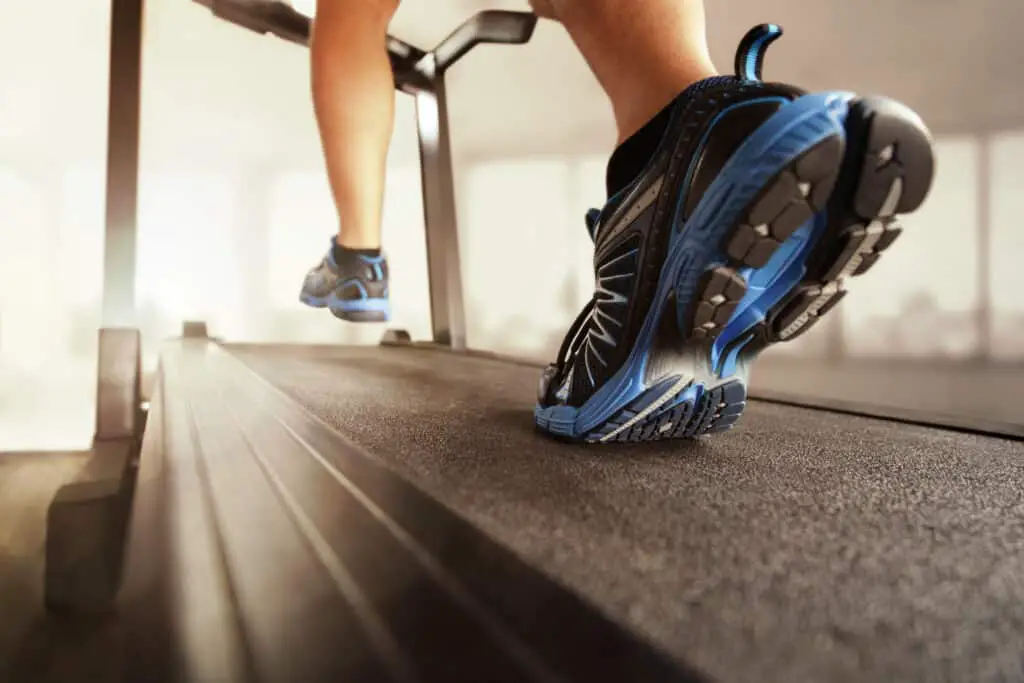
Weight loss is a very complicated topic but in principle, it’s simple: Burn more calories than you take in.
Jogging for 30 minutes is very doable for most people although it will take a few weeks to get to that level. If you’re very heavy, walking is a better choice. Jogging for 30 minutes will burn roughly 320 calories.
To get rid of 1 pound of fat, you need to burn 3,500 more calories than you’ve eaten over a period of time. That means you would burn 1 pound of fat in about 11 days by jogging for 30 minutes a day. That assumes you keep eating the same amount as you need to maintain your body weight without exercise.
I have to stress again; diet is key for weight loss. Jogging, walking, or running can help burn extra calories but you can’t outrun a bad diet. For example; a 50-gram candy bar has about 250 calories. Eating that takes about 30 seconds. It can take almost 30 minutes of jogging to burn that much.
Eating 100-200 calories less a day in combination with jogging 30 minutes will increase the weight loss to about 1 pound a week which is a healthy target.
Burning calories isn’t the only thing using a treadmill is good for though.
Is 30 Minutes a Day on a Treadmill Enough for Health?
Incorporating 30 minutes of daily treadmill activity into your routine can significantly benefit your health.
It helps in maintaining a healthy heart, improving endurance, and reducing the risk of chronic diseases like cardiovascular conditions, diabetes, and obesity.
150 minutes of moderate exercise a week is often touted as a good amount to improve many different health factors. So jogging 5 times a week for 30 minutes is enough to hit that target!
What Results to Expect From 30 Minutes on a Treadmill?
With consistent 30-minute treadmill sessions, you can expect improved cardiovascular fitness, increased calorie burn, enhanced stamina, and better mood. Even after just 2-3 weeks, you’ll notice significant differences.
How quickly you’ll notice weight loss depends largely on your diet. If your diet is in check, adding thirty minutes of cardio exercise to the mix will result in losing about 3 pounds a month. If you’re already fairly lean, that will be noticeable after a month. If you have a higher bodyfat percentage, it will take longer.
You’ll also notice increased muscle tone in the lower body after a few weeks. However, specific results vary among individuals and depend on factors such as exercise intensity, diet, and genetics. To maximize benefits, it’s essential to maintain a balanced and healthy lifestyle.
What Areas of The Body Do Treadmills Target?
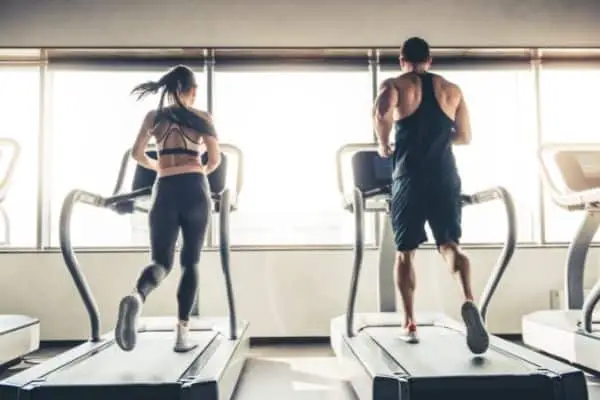
Treadmills use certain body parts more than others. However, that doesn’t mean you can use it to spot reduce fat in the used areas. A treadmill uses your hamstrings and glutes but that doesn’t mean your body will strip the fat of those body parts, fat loss doesn’t work that way. Burning calories will lower your overall body fat percentage but where that fat is removed depends on factors like: Genetics, age, gender, and hormone balance.
It’s better to think of running on a treadmill to burn calories and therefore lose overall body fat while improving cardiovascular health and strengthening your lower body muscles. Consistently running on your treadmill will start removing fat from part of your body.
Suggested: How to turn on your treadmill and use it for the first time
Cardio
Besides burning calories, treadmills are great at improving cardiovascular health. Running on a treadmill is very similar to running outside but there are some differences. However, from a cardiovascular perspective, they are very similar.
Aerobic exercise makes your heart and lungs work harder to get blood and oxygen to your muscles. This is the process that is strengthening your cardiovascular endurance while using a treadmill.
Regular cardiovascular exercise also has benefits for mental health, digestion, calorie partitioning, and many more processes in your body.
Suggested: How much does a treadmill for a home gym cost?

Lower Body
Treadmills don’t use the upper body in a meaningful way. Sure, running is a full-body workout and you move parts of your upper body but they don’t get activated to a large degree. Especially not if you compare it to lower body activation.
Treadmills mainly target the lower body. Good treadmills have the option to change incline settings to target different leg muscles, namely your glutes, hip flexors, quadriceps, hamstrings, and calves.
Suggested: Can you walk on a treadmill without shoes?
Running or walking on a flat treadmill will target the quadriceps more. The more you increase the incline, the more the focus pivots to the rear of the legs. So that means the higher the incline the more focus on the glutes, hamstrings, and calves.
Also, increasing the incline dramatically increases the amount of calories you burn because the intensity is much higher. Just like running outside on flat ground is much easier than running up a hill.
Unlike elliptical trainers, exercise bikes, or rowing machines, running on a treadmill means your feet impact the belt continuously. This can cause your joints and spine to start aching and your recovery time to be longer. Getting a high-quality treadmill with good damping in the belt will dramatically reduce the impact on every stride which means you recover quicker and can work out more often. In the long run (pun intended) this means you’ll see much better results with less injury risk.
Core
With every stride, your body naturally contracts your abs and other core muscles to keep you balanced and keep a straight posture. This will strengthen the core. The faster you run, the higher the core activation tends to be. If you’re untrained, you’ll get some core-strengthening effects from running. However, if you’re more advanced, just running isn’t going to be enough if you want to strengthen the core.
Running doesn’t activate and train the complete core either. And since it’s necessary to have a strong core for high-intensity exercise, it’s a good idea to do some separate core strengthening exercises besides running. Some simple bodyweight exercises can dramatically increase core strength in a few weeks if done regularly.
Are you looking for visible abs? Running on a treadmill still plays a big role. That’s because having visible abs requires the right combination of the ab muscles being big enough and having a low enough body fat percentage. A treadmill is a very useful tool to reduce body fat percentage. To really make your abs pop, it’s a good idea to do more ab exercises apart from running.
How Often Should You Use A Treadmill?
You can run on a treadmill every day if you want and you recover quickly enough. Adults are recommended to get at least 150 minutes of medium-intensity to vigorous exercise a week. Typically, people work out for 30 minutes a day, five days a week. This way you allow the body time to rest and recharge.
Suggested: Do you need a mat under a treadmill?
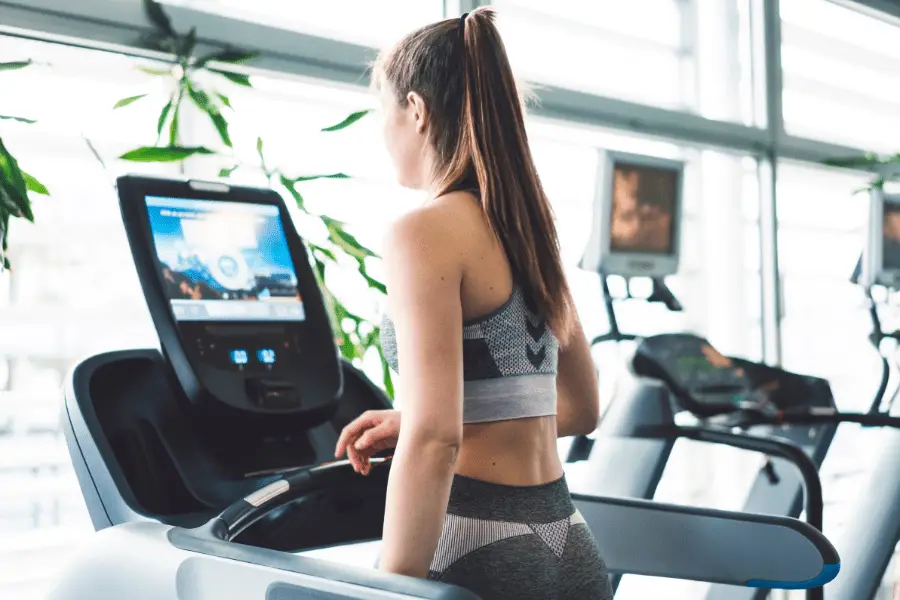
Exercising at least 150 minutes a week is recommended for preventing weight gain and general health. If you are looking to increase weight loss, however, you should be striving for around 250 minutes of exercise a week (while maintaining a healthy diet, of course). In that case, it is recommended to work out 45 minutes to an hour for five days a week.
There is nothing wrong with using the treadmill more than five days a week, as long as you are not doing long high-intensity sessions each day. If you want to run every day without breaks, it’s better to do longer but low-intensity workouts. However, rest days are always a good idea. Your body might not start complaining the first few weeks but if you keep up the schedule for a long period, you probably get some weird aches and pains that could have been prevented by taking time off.
Combining cardio exercise with resistance training will make your workouts even more effective. Varying your workouts makes them less repetitive and building some muscle raises your resting calorie expenditure which means you burn more calories while sleeping! Stronger and bigger muscles also make you look better and compound the physique improvements you get from fat loss.
What Can You Do To Make Your Treadmill Time More Effective?

Nutrition
Food is fuel. I’ve certainly used food as an emotional crutch at times but the biggest thing you can do for your health is improve the way you eat.
The key to increasing the results of your workouts, whether it’s running on a treadmill or other activity, is to eat balanced and nutritious meals. To get the most out of your physical activity, you have to be giving your body sufficient energy to perform. Some forms of energy are better than others.
Now, what is considered to be a balanced diet depends on what you are trying to accomplish. There will be a different amount of calories you should be consuming a day and a slightly different ratio of carbohydrates, fats, and protein (macronutrients).
Cook your own meals and try to avoid processed foods as much as possible. A good target to shoot for is to get 80% of your calories from whole foods. It’s very tough to eat 100% whole foods and shooting for 80% is more likely to give you enough leeway to be able to stick to it.
Typically, your ratio of macronutrients should be:
- 30–35% of your calories from protein
- 55–60% of your calories from carbs
- 15–20% of your calories from fat
(Source)
To lose weight, you need to be taking in fewer calories than you are going to burn from exercising. If your primary type of exercise for losing weight is aerobic exercise and/or weightlifting, then your ratio should include slightly more carbohydrates in your diet.
A kilo of fat has 7700 calories. So by consuming 550 calories less per day than you use, you’ll burn through a kilo of fat every two weeks. Running on a treadmill helps increase the amount of calories you burn in a day. So after doing this for 4-6 weeks, you’ll lose about 2-3 kilos (4.4 – 6.6 lbs.). For most people, this won’t be their goal but it will be visible.
If your goal is to bulk up and gain muscle, you actually need to switch between eating more calories and fewer calories. This is referred to as bulking and cutting. After identifying the number of calories you need to maintain your current weight, you will eat 15% more calories than that during your bulking phase. This is so you can build as much muscle as possible. Then you switch to your cutting phase and will eat 15% fewer calories than you need to maintain weight.
The purpose of the cutting phase is to lose as much fat as possible while keeping the muscle mass you built during the bulking phase. If fat loss is the main concern, start with reducing your calories. Since most people in the USA today are overweight, getting to a better BMI first is more important.
A note about protein: It is a myth that you need to consume significant amounts of protein to gain muscle. Strength training is how you will build muscle! Yes, your body needs protein to repair and grow the muscles but, if you consume more protein than your body needs in a day, it will be converted and stored if it exceeds your daily calorie needs. Thus, eating so much extra protein you go over your daily calorie goal, will actually go against your goal and reduce the efficiency of your workout. About 0.6 – 0.8 grams per pound of body weight is a good goal.
Strength Training Exercises
As you can read above, running on a treadmill mainly strengthens the muscles in the lower body. To strengthen other muscle groups or focus on some specific ones, you use strength training. Combining the calorie-burning and cardiovascular benefits of running on a treadmill with strength training is very effective and will multiply the effect you would get if you’re only doing one of the two.
The best way to include strength training exercises in your treadmill workout is to do them after running. That’s if you want to focus on weight loss. If you want to focus on muscle building, it’s better to do the strength exercises first.
It’s best to do a full-body strength workout that targets all body parts. If you don’t want to do all the body parts in one day, you can split them up as well. It’s best to hit all the body parts twice a week. Training your whole body creates a better overall physique and prevents major muscle imbalances. It also means you create more real-world strength that’s useful in daily life.
For a basic and compact home gym strength setup, click here.
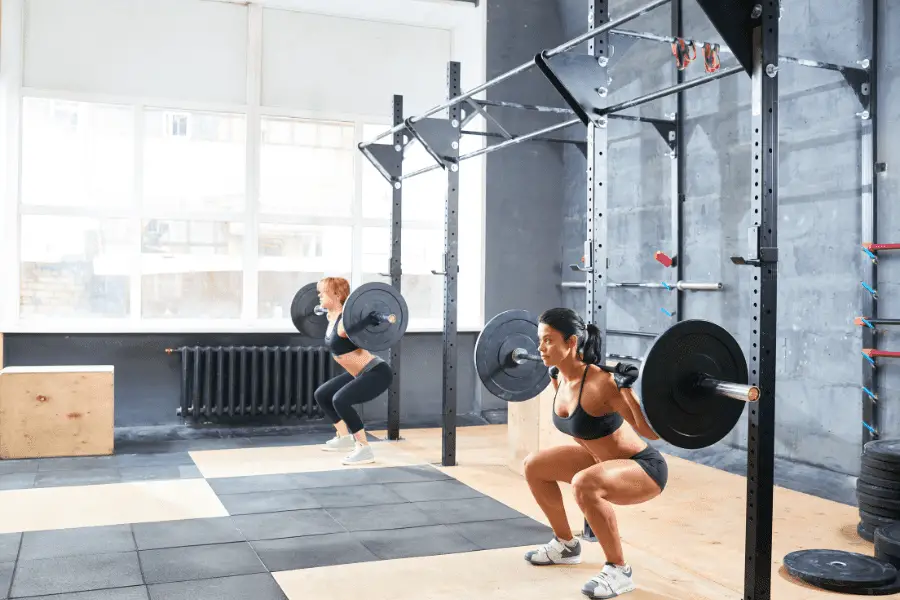
Stretching Before And After
Before and after any workout it is a good idea to stretch. If you begin working out without warming your muscles, you are more likely to injure yourself during your exercise. Stretching is a light way to warm up your muscles and prepare them to be used.
Good pre-workout stretches include:
- The Pike Stretch– Start by standing with your legs shoulder-width apart and reach down to put your hands in front of your toes. You’ll then slowly walk your hands forward while keeping them shoulder-width apart and keeping your legs straight. Essentially, you are walking yourself into the yoga stretch “downward dog.” Stay in that position for 30 seconds. This will stretch your hamstrings and calves.
- Trunk Rotations– Start lying on your back with your hips and knees bent and your feet flat on the floor. Your arms should lay straight at your sides. Squeeze your shoulder blades and flatten your neck to the floor while rotating your legs to the left. As you twist, your right shoulder blade and arm should remain flat on the floor. Hold that position for a few minutes and then slowly return to the starting position and rotate your legs to the right side. This will stretch your shoulders, legs, and core.
- Lunges– Lunges are an example of dynamic stretching, a way to stretch by constantly moving as opposed to holding a pose for a long amount of time. Since lunges target the leg muscles and back, doing a set or two of them before getting on the treadmill can help get the blood flowing through your legs and prepare them for endurance.
Good post-workout stretches include:
- Chest Stretch– Start by standing with your feet slightly wider than shoulder-width. Place your hands on the back of your head with your arms raised and elbows pointed to the sides. Bring your shoulder blades together as you press your elbows backward.
- Seated Glute Stretch– Start by sitting in a chair with one foot flat on the floor. Place your other leg so that its ankle is over the knee of the foot flat on the floor. Slowly bend forward while keeping your back straight until you feel a slight pull in your hips and glute muscles. Hold that position for 30-60 seconds and repeat with the other leg.
- Cat-Cow Stretch- Start with your hands and knees on the floor, with your spine straight and relaxed. As you inhale, press your chest forward as if making your back into a bowl. As you exhale, relax your shoulders, and round your spine upward, and press your hips forward as if making your back into a hill. Relax your shoulders and continue to go between these positions for a minute.
Favorite Cardio Accessories
Check out these accessories that improve a home cardio workout:
- Equipment mat: All cardio equipment should be put on an equipment mat. The Rubber-Cal mat (Amazon) is an affordable yet very high-quality choice.
- Interval timer: To time your intervals and workouts, there is no better choice than the GymNext Flex. It’s super easy to use and set up with a phone app.
- Tablet holder: Cardio can be boring. With this tablet holder (Amazon) you can follow along with on-demand workouts or just watch a movie on any cardio machine.
- Heart rate monitor: Monitoring your heart rate is very important while doing cardio. The Polar H10 (Amazon) connects to almost anything you can imagine and is very accurate.
To find which cardio machines I recommend for home gyms, click here.
